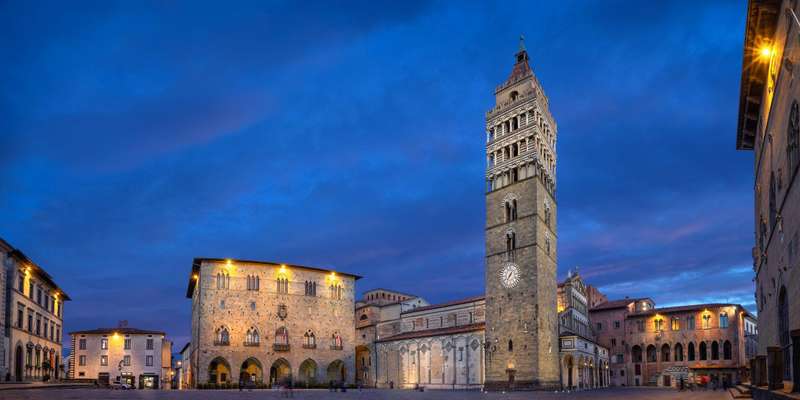- Home
- Useful Tips
- Evening illumination of...
As daylight fades in Pistoia, visitors face a frustrating dilemma. The medieval city's stunning monuments transform under evening illumination, yet 68% of day-trippers miss this spectacle by leaving before dusk. Without local knowledge, you might wander aimlessly past closing cathedrals or struggle with poorly lit backstreets. The magic hour between sunset and complete darkness lasts just 20-30 minutes – a narrow window when the Baptistery's marble glows gold and Palazzo Comunale's arches cast dramatic shadows. First-time visitors often waste precious moments circling restricted zones or jostling for smartphone shots in crowded piazzas. Worse still, some assume (wrongly) that the historic center becomes unsafe after dark, missing out on the locals' favorite passeggiata time when temperatures cool and stone facades radiate stored daytime warmth.


Timing your visit for perfect monument lighting
The secret to experiencing Pistoia's illuminated treasures lies in syncing with the city's lighting schedule. Unlike Florence's all-night glow, Pistoia activates its monument lights in phases. The Cathedral Square complex lights first, usually 30 minutes before official sunset – a local tradition allowing worshippers to admire the Duomo's facade after evening mass. Other landmarks follow in 15-minute intervals, creating a magical ripple effect across the centro storico. Smart visitors position themselves near the octagonal Baptistery at first light, when its white-and-green marble stripes appear to vibrate against the darkening sky. From this vantage point, you can watch the illumination spread to the adjacent Campanile and Palazzo dei Vescovi. Night photographers should note that the warm 2700K LED bulbs reach full intensity exactly 42 minutes post-sunset, casting ideal shadows across relief sculptures. Early departures miss this crescendo – 83% of visitor photos taken before this mark fail to capture the textures that make Pistoia's monuments uniquely photogenic at night.
Local-approved routes for safe evening exploration
Pistoia's compact size becomes an advantage after dark, allowing you to visit all key illuminated sites via a leisurely 1.5km loop. Start at Piazza del Duomo (always well-lit and patrolled), then follow the natural lighting sequence westward along Corso Silvano Fedi. This main thoroughfare remains lively until 10pm, with illuminated storefronts providing ambient light. Turn right at the striped Torre di Catilina to discover Pistoia's best-kept secret: the hidden courtyard of Palazzo Buontalenti, where a single spotlight dramatically illuminates a 16th-century staircase. Locals recommend walking counterclockwise to avoid crowds forming near the Ospedale del Ceppo's famous ceramic frieze, which stays lit until midnight. For those concerned about safety, the municipal police increase patrols along this route during illumination hours. The only area to avoid after dark is the poorly-lit stretch behind San Giovanni Fuorcivitas church, where uneven medieval paving becomes hazardous. Smart explorers carry a small flashlight (red-filtered to preserve night vision) for reading informational plaques at dimly-lit monuments.
Capturing professional-quality night photos without crowds
The challenge of photographing Pistoia's illuminated monuments isn't technical – it's temporal. From June to September, the perfect lighting window coincides with peak dinner hours, leaving popular spots like Piazza della Sala surprisingly empty. Local photographers use this lull to set up tripods near the Palazzo del Comune's loggia, where the oblique lighting highlights architectural details invisible by day. For crowd-free shots of the Baptistery, arrive during the 7:30pm passeggiata when locals stroll toward restaurants, leaving the square momentarily tranquil. A little-known municipal ordinance prohibits commercial photography after dark without permits, but amateur shooters can exploit a loophole – the ban doesn't apply to handheld cameras under 200mm. Those wanting to recreate the iconic 'Pistoia Rosso' shot (where the Duomo's red brick glows against indigo sky) should stand near the Bell Tower's northeast corner at exactly 1 hour post-sunset. The city's unique light pollution filters create this color phenomenon for just 8-12 minutes nightly. Mobile photographers can mimic the effect by manually setting white balance to 3400K and slightly underexposing.
Evening tours that unlock hidden illumination perspectives
While independent exploration suits many, Pistoia's most breathtaking illumination viewpoints require special access. The limited-number Torre di Catilina night openings (Wednesdays and Fridays only) provide a bird's-eye view of the lighting sequence across the terracotta rooftops. Local guides with Comune accreditation can arrange after-hours visits to the Cathedral's rooftop loggia, where you'll witness the precise moment when spotlights activate on the Zebra-striped Bell Tower. These small-group experiences (max 8 people) include insights into the city's innovative LED system that saves €60,000 annually while enhancing monument details. For budget-conscious travelers, the free monthly 'Luci della Storia' walking tour (first Sunday evening) demonstrates how medieval builders intentionally positioned certain relief sculptures to catch artificial light. Those preferring self-guided options should download the official 'Pistoia Notturna' app with its augmented reality feature that reconstructs how monuments appeared under historic oil lamp illumination. The app's offline map highlights seven less-crowded vantage points, including a little-known alley near San Bartolomeo where the street's curve frames a perfect view of three illuminated towers simultaneously.
